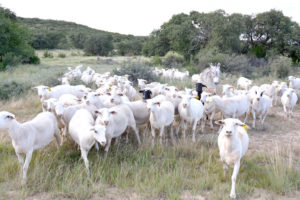 Texas lamb, goat meat markets thriving amid high demand
Texas lamb, goat meat markets thriving amid high demand
Texas lamb and goat meat producers continue to command high prices in a niche market driven by high demand and low supplies, according to a Texas A&M AgriLife Extension Service expert.
Reid Redden, AgriLife Extension sheep and goat specialist and interim director of the Texas A&M AgriLife Research and Extension Center, San Angelo, said the Texas lamb and goat markets have thrived despite COVID-19 and that travel restrictions likely helped spur demand higher.
“The lamb and goat markets are in another world as it relates to market conditions most Texas ag producers have been dealing with,” he said. “The market for Texas lambs and goats is diverse, resilient and growing. It avoided supply chain bottleneck issues other livestock markets dealt with, and I think the COVID restrictions kept the regular consumers home, which means more family functions to eat lamb and goat meat.”
Texas producers continue to command top prices as they supply a niche market around the U.S., Redden said.
In January, the base price for 60-pound lightweight slaughter lambs was $3 per pound, up 70 cents per pound from this time last year, he said. Those lambs are selling $1 per pound over the five-year rolling average.
Overall, consumer demand for lamb has expanded in recent years. But Redden said Texas lambs have commanded premium prices through the nontraditional market compared to the traditional market for restaurants or retail sale.
The traditional feeder market, which prefers larger framed, wool-type lambs fed to 140-180 pounds, and mimics the beef industry as far as processing and logistics, is not as common in Texas as it used to be, he said. The vast majority of Texas lambs are smaller-framed hair sheep that typically weigh 40-80 pounds, and prices for Texas lambs are driven primarily by the demand from diverse consumers concentrated in major population centers around the state and nation, Redden said.
Lambs are shipped live to the markets where they are sold directly to consumers or harvested by processors and distributed to specialty grocers and butcher shops. These nontraditional markets demand smaller, leaner lambs and pay a premium for them.
“The market has been strong for some time now, but prices continue to trend upward,” he said.
Prices reflect demand
Lamb production is limited in the U.S. because very few regions have climates and production conditions that sheep perform well in compared to other livestock.
Redden said Western parts of Texas are ecologically perfect for sheep. Native plant species include many varieties of browse that sheep find palatable, and the arid conditions make controlling internal parasites easier.
A significant piece of the traditional U.S. lamb market is supplied by imports, and they are one-third to half the cost of domestic lamb. But imported lambs do not appear to have as large an effect on the markets supplied by Texas lambs and goats, he said.
Many consumers want lambs at 40-60 pounds, but producers are realizing better margins at 60-80 pounds, Redden said. These market conditions factor into maintaining and inflating strong prices as buyers jockey for specific weight and class lambs.
“It’s a specialty market, and it’s become harder and harder for supplies to meet demand,” he said. “The prices reflect that.”
Goat prices strong, getting stronger
Goat prices continued to experience a price trajectory similar to lamb, Redden said.
“The kid goat market is even brighter than lambs,” he said. “The goat market has been on fire the last several years and getting better and better. Producers don’t understand it, but they’re just riding the wave as far as it will go.”
Unlike Texas’ lamb market, goats have never been part of the traditional meat production apparatus, Reid said. There are no big processing plants or packers, and production feeds nontraditional demand.
From January and February, goat prices fluctuated between $3.50 and $3.80 per pound compared to a five-year average of $2.50 to $2.75 for the same time of season. January-March is typically when prices are the best. Kidding season is just now getting started and most market goats are sold in the summer and fall.
Goats are lighter, slower-growing animals compared to sheep, Redden said. Market kid goats tend to be lighter than lambs — typically averaging 35-65 pounds — but are achieving comparable prices per head due to higher prices. Some goats have brought over $4 per pound at market.
“There was one down week last year when buyers were worried about the COVID-19 pandemic, but as soon as the orders kept coming in, prices took off and have continued to climb,” Redden said. “There just aren’t enough goats to meet demands.”
Redden said it was noteworthy that even the cull nanny market was very strong, meaning buyers are willing to pay top dollar for less desirable goats. They were selling at $2.20 per pound in February, 85 cents per pound above the five-year February average for 100-pound nanny goats of $1.35 per pound.
Redden said goats, like Texas lambs, are in high demand in major population centers across the state and country. While lambs are more adaptable to other production conditions, western parts of Texas are ideal for goat production due to browse requirements and low internal parasite load.
About 40% of U.S. goat production is located in West Central and West Texas, Redden said. About 30% of goats consumed in the U.S. comes from imports. Australia has been a major player in the import market, but their goats are primarily feral herds, and they aren’t able to increase production to meet the growing demand. As such, imports have very little impact on domestic goat prices.
“You see people with a few hobby goats here and there, but the major producers who are experienced with the infrastructure and know-how to handle a commercial goat herd are generally located in Texas,” he said. “There’s interest in goat production because prices have been so good, but they are a lot of work, and I don’t predict large increases in goat production outside the state.”




0 Comments